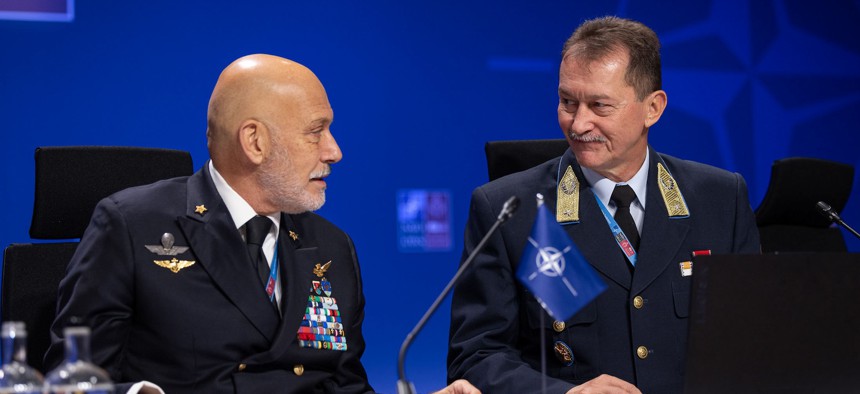
RIGA, Latvia — If Russia again encroaches in NATO-member airspace, officials say they now have set expectations about how that nation will respond—and the list includes options from tracking the Russian aircraft to shooting them down.
Over the past week, NATO leaders have been working to bring more “coherence [and] synchronization across all of the air policing activities,” one senior military official told Defense One Saturday at the NATO military committee meeting here. However, NATO members still have to work through issues around specific authorities and rules of engagement, the official said. “Some countries have some legal limits. Some countries have some administrative limits that they must get political approval for. But it’s all being smoothed out.”
Escalating Russian incursions have led to a variety of actions just this month, from shootdowns of Russian drones over Poland on September 10 to a NATO-led escort of fighter jets out of Estonia a little more than a week later. And top officials of NATO countries have promised swift responses. Poland, for instance, has said it will shoot down drones with or without NATO permission.
Adm. Giuseppe Cavo Dragone, chair of the NATO military committee, said the rules of engagement for how NATO members respond vary tremendously by the threat level of each incident, such as whether the drones or jets are known to be armed. The determination may come down to the pilot or reach all the way up to the NATO Supreme Allied Commander Europe. Rules of engagement are a “tool that can evolve as far as the threat is changing,” he said.
NATO military committee members spent much of the weekend discussing new assets and strategies to give individual members more options to deal with future incursions, as part of Eastern Sentry, which was launched Sept. 12 in response to the Polish incursion. The activity converts the air policing mission to a broad air defense mission. Denmark will likely soon contribute an anti-aircraft frigate and two additional F-35s to Eastern Sentry, according to an individual with knowledge of the discussions.
The change from policing to air defense may not be obvious to the general public. But it will be significant behind the scenes, according to the senior NATO official. The difference is that, depending on the incursion, Eastern Sentry gives SACEUR elements to address the threat quickly— for instance, moving a battlegroup from Latvia quickly into Estonia and then returning it, to “mass our capabilities at the point of need,” the official said.
The official said future incidents are likely, but they believe Russian President Vladimir Putin is not personally directing the incidents. Rather, they said, the incursions speak to a “culture” within the Russian military, which accepts a “higher degree of risk” for provocative actions.
Still, NATO’s obligation now is to respond to each incident proactively. “If [Putin] sees a weakness in our response, you very well may see him start to hand-puppet,” as in direct future incursions himself, the official warned.
The meeting here Saturday occurred in the context of growing uncertainty about the future role of U.S. forces in Europe. While Trump has indicated that the United States is likely to stay in NATO, defense leaders such as Defense Secretary Pete Hegseth have for months foreshadowed a potential drawdown of U.S. forces in Europe, and the new White House national defense strategy is likely to de-emphasize Europe as a chief U.S. national concern.
When Defense One asked Dragone how prepared other NATO members are for fewer U.S. troops in Europe, he answered, “This is something that has been discussed a lot,” downplaying the concern as “normal” for any military alliance.
“Let’s assume that one of the allies, the bigger one, needs to reorient some of his energies [in] some other direction,” the official said. NATO countries, working together, will “rebalance everything in the most efficient and effective way… We’re going to work it out and face it like a big man.”
The post NATO members say they’re confident, mostly coordinated on how to deal with Russian drone threats appeared first on Defense One.




